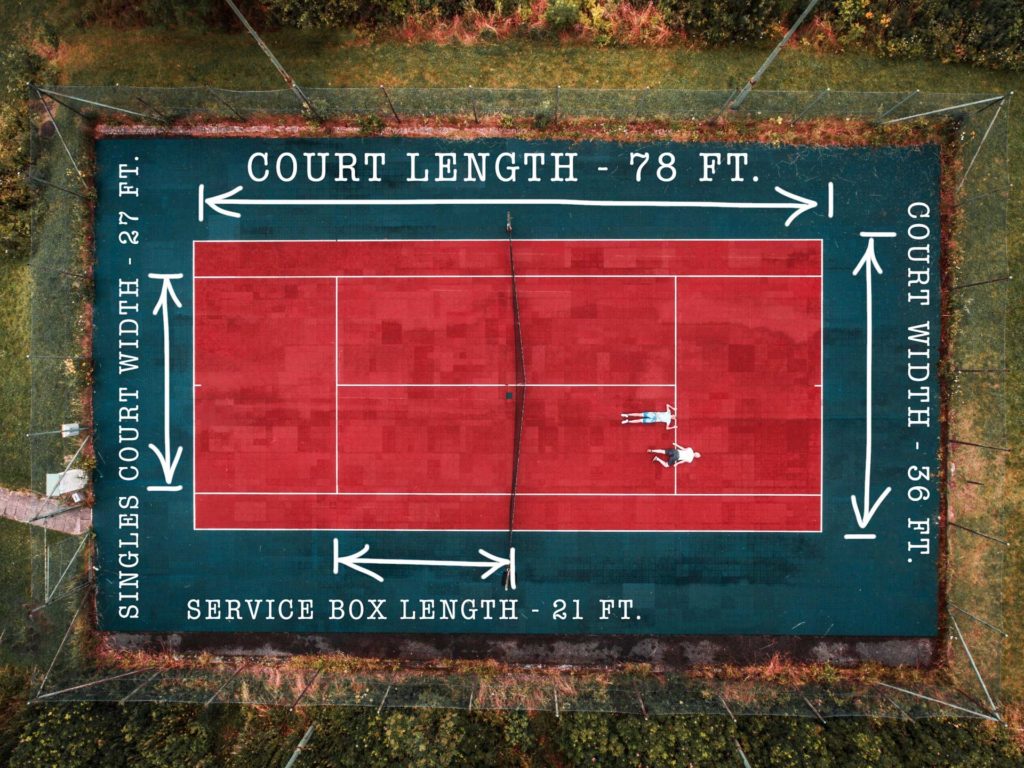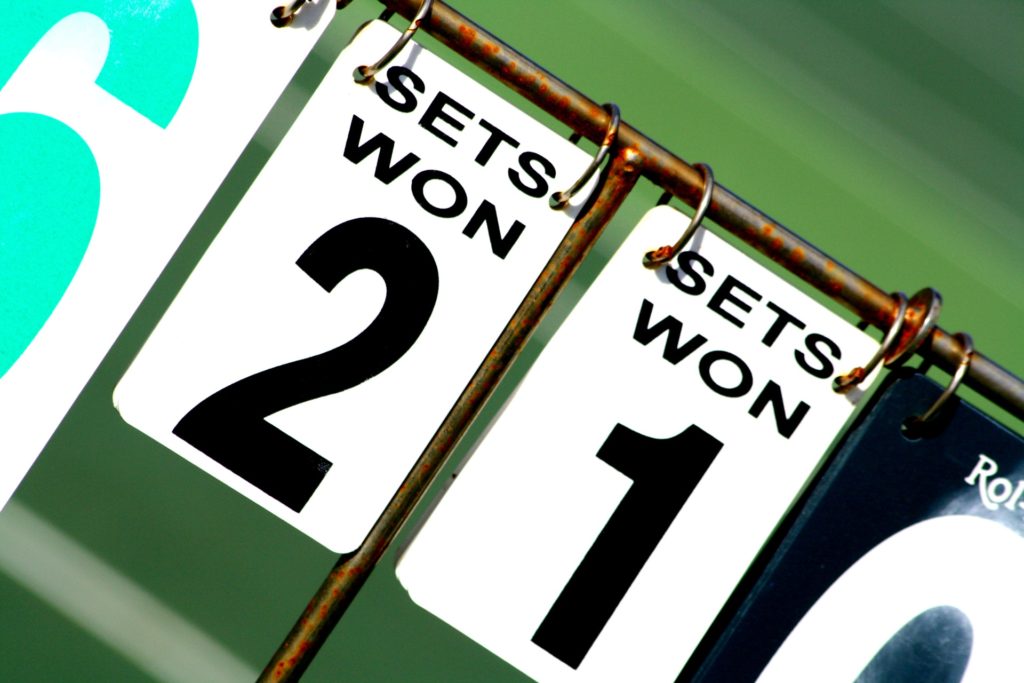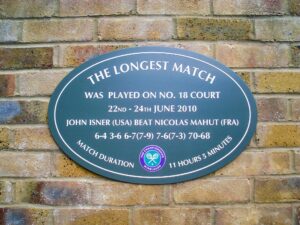Are you new to the game of tennis? Well not to worry, we have you covered. We’ve put together a great guide covering the most important rules of tennis, from the basics to some of the rules that even some of the pros might not know. So what are the rules of a tennis game?
The Basic Rules of Tennis
- In a game of singles, 2 players play against each other.
- Each tennis player stands on opposite sides of the net and uses a tennis racket to hit the ball back and forth.
- The point starts with one of the players performing a serve, and the other player attempting to return the serve.
- A serve must bounce in the service box before it can be returned.
- If the server misses the service box, this is considered a FAULT. In this case, the player has a second chance to put the ball in play. This is known as a SECOND SERVE.
- If the server misses the second serve, this will be classed as a DOUBLE FAULT and the server will lose the point.
- If the serve hits the net cord and bounces inside the correct service box, this is called a LET and the serve is repeated.
- If the opponent fails to return a valid serve, the point goes to the server.
- Once in play, each player will attempt to win the point by keeping the ball within the court and preventing the opponent from getting the ball back or forcing them to make a mistake.
- The point will end when someone misses the ball, hits the ball out of the court or into the net, or the ball bounces twice.
- If the ball hits the net cord and bounces over the net (on the correct side), the point continues.
- When in play, the player cannot touch the net or net post, or cross over onto the opponent’s side of the court. If they do, this player will lose the point.
- A player can only hit the ball once before returning it to the other side of the net.
- The boundary lines of the court are considered part of the court. If a ball hits the line, it is considered to be IN.
The Tennis Court Dimensions

- Baseline: The baseline is the line furthest from the net on either side of the court, running parallel to the net. The baseline limits the length of the court and is the line the players will serve from.
- Centre Mark: The centre mark is the small division line on the baseline that divides the court into two halves. It is primarily used as a guide to determine where a player should stand when serving. A player will stand on one side of the centre mark and serve to the service box in the other half of the court, on the other side of the net (so diagonally).
- Service Line: This is the line running parallel to the net, half way between the net and the baseline. It marks the length of the service box. When serving, the ball must bounce in front of the service line.
- Centre Line: The centre line is the line running perpendicular to the net from it’s centre, and divides the service boxes.
- Singles Sideline: The singles sideline is the innermost line spanning the entire length of the court (perpendicular to the net). There are two per court, one on the left and one on the right, and they limit the width of the court.
- Doubles Sideline: The doubles sideline is the outermost line spanning the entire length of the court (perpendicular to the net). Again, there are two per court and limit the width of the court. The doubles sidelines are, as the name indicates, only used when playing doubles tennis.
- The Net: The net divides the court into two ends. At the centre it measures at 3 feet tall (0.914 metres), though at either net post it measures at 3 feet 6 inches (the net sags) if a doubles net is used, which is common in modern tennis.
- The Surroundings: At recreational level the minimum distance required around the court is 5.49 metres behind the baseline and 3.05 metres to either side. At competition level, the minimum distances are 6.40 metres behind the baseline and 3.66 metres to either side.
- The Lines: The thickness of each line also varies according to official rules. The centre mark is 4 inches in length and and no wider than 4 inches. The service line and centre line is 2 inches wide and all other lines on the court are between 2-2.5 inches wide. Again, if a ball bounces on the line, it is considered IN.
Tennis Scoring - Point, Game, Set & Match

Game
A standard game consists of a minimum of 4 points. The score of the server is called first, and goes as follows:
No point = “Love” | First point = “15” | Second Point = “30” | Third Point = “40” | Fourth Point = “Game”
For example, if the server wins the first point, the score is “15 – Love”. If the receiver wins the first point, the score will be “Love – 15”. The game is won when a player wins 4 points with at least 2 clear points. If each player wins three points, the score will be “40-40”. This is known as “DEUCE”. After Deuce, the score will be “ADVANTAGE” to the player who wins the point. If that same player wins the next point, they will win the game. If they lose the point, the score will return to Deuce.
Set
A Set consists of 6 Games and is won by the first player to reach 6 games, with at least a 2 game lead.
At the start of a set, Player A will serve for the duration of the first game. The players will then switch ends of the court, and Player B will then commence serving. After this, the player will continue to switch ends every 2 games.
If a set goes to 5-5, the set will be extended to 7.
If the set reaches 6-6, the winner of the set will be determined in a “Tie break”.
Tie Break
In a Tie break, a player must win 7 points with at least a 2 point lead. The first player to win the 7 points, provided there is a margin of two points over the opponent, will win the Tie break and the Set. Regarding the serve, Player A will serve for the first point, with the serve alternating every two points after that.
Match
A regular match will usually be played to the best of 3 sets, with either player requiring 2 sets to win the match.
The format/length of a match will depend on the event played. In professional matches, men’s and women’s matches are played to the best of 3 sets.
However, certain events on the men’s pro tour involve matches played to the best of 5 sets. These are the majors, also known as Grand Slams (Australian Open, Roland Garros French Open, Wimbledon and the US Open) and the Davis Cup.
The Rules in Doubles Tennis
Though mostly the same, the rules in a game of doubles are a little different to the tennis rules in a game of singles. The obvious difference is that there will be two players on either side of the net. As a result, the court size is increased and the tramlines become part of the court.
The Tennis Rules You Probably Don’t Know About Tennis
What happens if the ball hits the net post and bounces in?
As the net posts are considered to be part of the net, if the ball hits the net post and then bounces inside the court, the point continues. However, this only applies in a rally and not to a serve. In a singles match played with a doubles net and singles sticks, the fixed net posts and the part of the net outside the singles sticks are considered to be permanent fixtures and not part of the net. If the ball hits any permanent fixture before bouncing in, it is considered to be OUT and the player will lose the point. [ITF Rule 2, 19 Case 2 & 24 section d)]
What happens if a tennis ball hits a player?
Whilst the ball is in play, a player can only touch the ball with his tennis racket. If the ball touches the player on any part of their body or clothing, the player will lose the point. [ITF Rule 24 section i)]
Can you touch the net in tennis?
No, you can’t touch the net in tennis. A player can’t touch the net until the point is over, with any part of their body, clothing or racket. If a player touches the net our runs into it, they will lose the point. [ITF Rule 24 section g)]
Can you throw your racket in tennis?
No, a player can’t throw their racket to hit the ball. In order for the shot to count, the racket must be in the player’s hand when the ball is hit. However, if the racket is released/dropped after the ball is hit, the point will continue. [ITF Rule 24 section j)]
Can a player make noise during a point?
No, a player can’t throw their racket to hit the ball. In order for the shot to count, the racket must be in the player’s hand when the ball is hit. However, if the racket is released/dropped after the ball is hit, the point will continue. [ITF Rule 24 section j)]
Can a player whiff the ball?
Yes, a player can whiff the ball when it’s in play or during a rally. However, during a serve, if the player tosses the ball, swings for a serve and misses of whiffs the ball, and the ball then bounces, this is considered a fault (Note: if the player whiffs the ball on serve, they may still attempt to hit it before the ball bounces!) [ITF Rule 16 & 19]
Can any player call a let in tennis?
Each player or team is responsible for line calls for shots landing on their own side of the net. A player or team is not allowed to make calls for balls landing on the opponent’s side of the net. However, as the net is considered to be in the middle, any player can call a let during a serve. [USTA The Code, Page 51 #27]
Can you reach over the net in tennis?
Usually a player or their racket can’t cross over the plane of the net. However, a player can follow through with a swing across the net only when first making contact with the ball on their side of the net. There is however an exception to the rule (read the next question). [ITF Rule 25 e)]
What happens if a tennis ball spins back over the net?
If the ball spins back over the net, or in other words bounces on one side and then bounces back without the opponent hitting it, the point goes to the player that hit the ball, assuming the opponent can’t and doesn’t get to the ball. If the opponent can indeed get to the ball, the player may reach over the net to hit the ball. This is the only scenario in which a player may hit the ball on the other side of the net. [ITF Rule 25 b)]
Can you double hit in tennis?
If a player hits the ball twice, unintentionally and during a single swing of the racket, the shot is valid. [ITF Rule 24 f)]
Can you hit the ball around the net in tennis?
Yes, you can hit the ball around the net in tennis. [ITF Rule 25 b)]
Check out the video below:
And that’s it! If you’d like to learn more about the rules of tennis, check out our more in-depth guides to tennis court dimensions and tennis scoring. Other than that, you should be all set to grab a racquet and take to the court.




